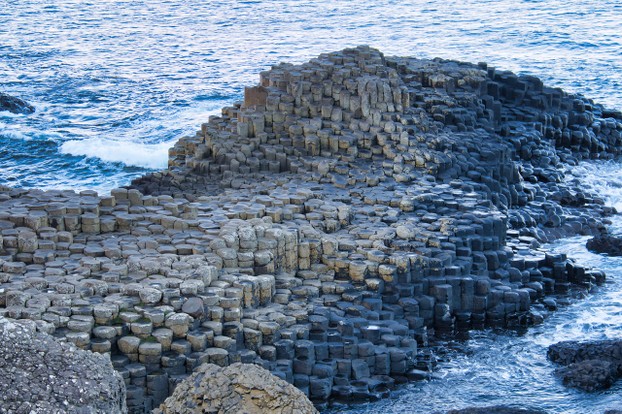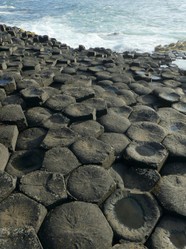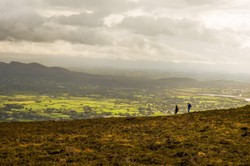This was not my first visit to the Causeway, but the two visits were very different. Some years ago I scrambled over the slippery, spray-soaked black basalt columns, confident in my nimbleness, sure of foot on uneven ground. But this time, now a septuagenarian with mobility difficulties, I chose [needed] to take the mobility taxi, which wends its slow course down the road that leads down to the rocky headland and strand. We had a friendly and competent guide, Mark, who delivered a talk on the geology and folklore of the causeway. The talk was professionally delivered, and well-informed. A very satisfying experience. I have studied some geology, but he told me some things that I did not know. The passengers included a friendly Northern Irish lady and her daughter, who acted as her mother's carer. They added to the good atmosphere of the trip.
We alighted in a carpark at a headland composed of a mass of hexagonal columns, all showing signs of the inevitable erosion. The natural colour of the basalt is black, and this is clear in those columns washed clean by the surging Atlantic waves that thunder on Ireland's north coastline, but higher up the headland and consequently drier, the rocks have acquired a grey patina and at spots a covering of light-green lichen. I was soon met by the other members of my party, my wife, son and four year old grandson. The grandson was thirsting for adventure, so my son took him on the easy scramble up the low headland, followed by my wife, Maureen. They disappeared from view for a while, only to reappear on the descent, which Maureen took more slowly than the adventurous four year old and his father took.
In the meantime I had realized that with my mobility problems I could not handle anything but a flat surface, so I picked a seat and took in the view. Not being able to scramble was frustrating ,but medical issues mean that I cannot climb even a ladder. So I simply took in the view. Behind me was the hump of rock that comprises a significant part of the causeway, but before me was a wide expanse of rocky bay. The shore is not sandy, but is a commingling of sand, rock and seaweed, on all of which the summer sun beamed beneficently down. A ridge of dark rock cropped up in mid-bay, and if you use your eyes and minds it is easy to see how it extends into a cluster of dark islets further to the east. The ridge is diorite, an igneous rock harder than basalt, which has therefore resisted erosion more successfully than the basalt of the Causeway has done. Our guide had informed us that the bay was once a hive of industry, when the Northern Irish used to harvest the extensive kelp beds to sell to the nascent chemical industry. This arduous chore is now gone, but as there is a great future for seaweed harvesting, a sea vegetable trade is being reborn. The bay was once rich in Atlantic salmon, but no one now makes a living from this now scarce species.
My ruminations were interrupted by the need to re-board the mobility bus and return to the top of the cliff. I said a short farewell to this beautiful spot and left.








 TheThousand Year Gardenon 11/26/2025
TheThousand Year Gardenon 11/26/2025
 Women of the Gospelson 10/11/2025
Women of the Gospelson 10/11/2025
 Religious Gardenson 08/25/2025
Religious Gardenson 08/25/2025
 Doctor of the Church: John Henry Newmanon 08/03/2025
Doctor of the Church: John Henry Newmanon 08/03/2025



Comments
I think that people get used to the smell, when the kelp drive up it crumbles into fragments and eventually dust, and the smell goes away.
Thank you!
So everybody must know when someone's gardening with kelp!
How would one be able to work without getting sick? Would gardeners wear COVID-like face masks?
There is no way of eliminating the smell.
Thank you!
Some Unitedstatesians find kelp a bit fishy-smelly to use.
Might that be the case on your, eastern-pond side?
If so, might British ingenuity have figured out how to cancel it out or to mitigate it in some way?
Once or twice a year at least.
Thank you!
How often does kelp need to be applied and re-applied as fertilizer?
Kelp rots down when used as fertiliser. None was left to burn.
Your comment June 17, 2022, in answer to my previous question the day before, ascribes to kelp a fertilizing role in Irish agriculture and horticulture.
What did ancient, and what do traditional, Irish agriculturists, gardeners and horticulturists do when they deal with spent kelp?
Might that kelp be burned and its ashes spread over the soil or used in heating food and water?
Your knowledge of crystallography is better than mine. I can only report my experiences,which are now limited by disability.I would have loved to scramble over the rocks,but those days are gone.
Basalt is common throughout the world. And the fine grains indicate quick cooling, since the individual crystals would stop growing once solidification occurs. This would be consistent with surface cooling rather than cooling deep in the Earth.
I would think the large columns were made of small crystals that come together. One basis rule in crystal formation is 5 and 7 sides are impossible. A crystal must relicaate the structure, so all verticies on any face must fit with the next identical piece. So, the larger structure feature must be a clustering of small crystals, not individual crystals.
For example, a five-sided regular polygon has interior angles of 108 degrees, but 3 X 108 is 324 degrees. So, when fitted together there is a 36-degree gap. This gap cannot exist.
So, they are not large crystals, but do exist. Also, if they were large crystals they would all have the same number of sides. So, why are they shaped as they are? Interesting dilemma. Something has caused the columns to have their shapes.